Young, enthusiastic but are they ready for the road?

Passing your driving test and getting behind the wheel is a big step to independence for many young people. But those would-be drivers under the age of 25 face a host of challenges from the moment they first put an L plate on a car. In this report, we look in detail at the difficulties learner drivers must overcome in order to get their licence, from the costs of lessons to the varying success rates at different test centres.
Gaining the licence is just the start of the motoring journey though for those under the age of 25. We have also dug deep into the data to unearth the facts around the cars younger drivers opt for, those they aspire to drive, and how the cost of car insurance for young drivers compares to those motorists who have been around the block more than once.
One of the reasons younger drivers have traditionally been quoted higher insurance premiums is because they are seen as a higher risk. In this report we identify the mistakes young drivers are most likely to make behind the wheel, what is most likely to lead to accidents involving young drivers, and the potential repercussions.
Learning to drive
Learning to drive is the first step on the road to four-wheeled freedom, but the costs may leave young drivers feeling like the handbrake has been left on.
The UK is one of the cheapest nations in the world when it comes to the cost of a single driving lesson, at an average of £24 a session. But when the other costs of learning to drive are accounted for, it’s a considerable sum.
Firstly, drivers need a provisional licence, which costs £34. If they have the recommended number of 47 lessons the total cost would be over £1,100. The tests themselves cost a minimum of £85 for both the theory and practical which can bring the typical cost of learning to drive to a whopping £1,247.
That makes the UK the fifth most expensive country to learn to drive worldwide.
How long do young drivers spend as ‘learners’ on average?
When it comes to learning to drive, being younger is beneficial. The average car insurance policyholder with Admiral who is under 25 years old had a provisional licence for just one year and five months.
That’s much quicker than the two years and ten months that it takes drivers of all ages to earn their full driving licence.
Taking the test
Taking the driving test marks the end of the learning journey and the beginning of potential ‘freedom of the road’ - and it seems would-be drivers are keen to get it done young. Almost 70% of those who sat the theory test in 2017/18 were aged 25 and under.
If at first you don’t succeed… try, try again?
Based on the last five years, almost half of drivers aged under 25 passed both their theory and practical driving tests first time.
While young female drivers (under 25) are more likely to pass the theory test first time, with a 51% pass rate compared to 47% for male drivers, the reverse is true with the practical test. Fifty-one per cent of young male drivers (under 25) pass their first practical test, compared to 48% of female drivers.
On average it takes young drivers two attempts at the practical test before they pass.
Faults on a test
No more than 15 minor faults are allowed in a test, or it’s a fail. The vast majority of tests taken by young drivers include at least a couple of minor faults. In 2017-18 just 2.6% of all tests passed by men were faultless, dropping slightly to 2% for female drivers.
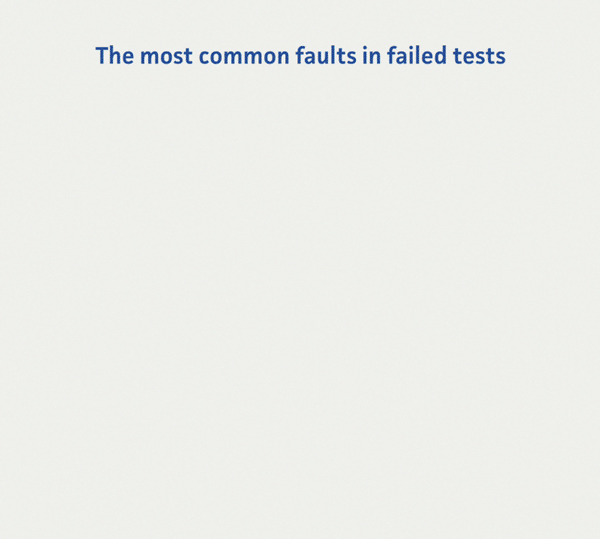
Location, location, location
Learner drivers could give their chances of passing first time a boost by reconsidering where they take the practical test.
Admiral analysis found that the Golspie test centre in Scotland boasts Britain’s highest driving test pass rate at 82.1%. That’s significantly higher than the national average of 47%, and nearly three times higher than the lowest pass rate, which comes from the Belvedere test centre in London, at just 28.3%.
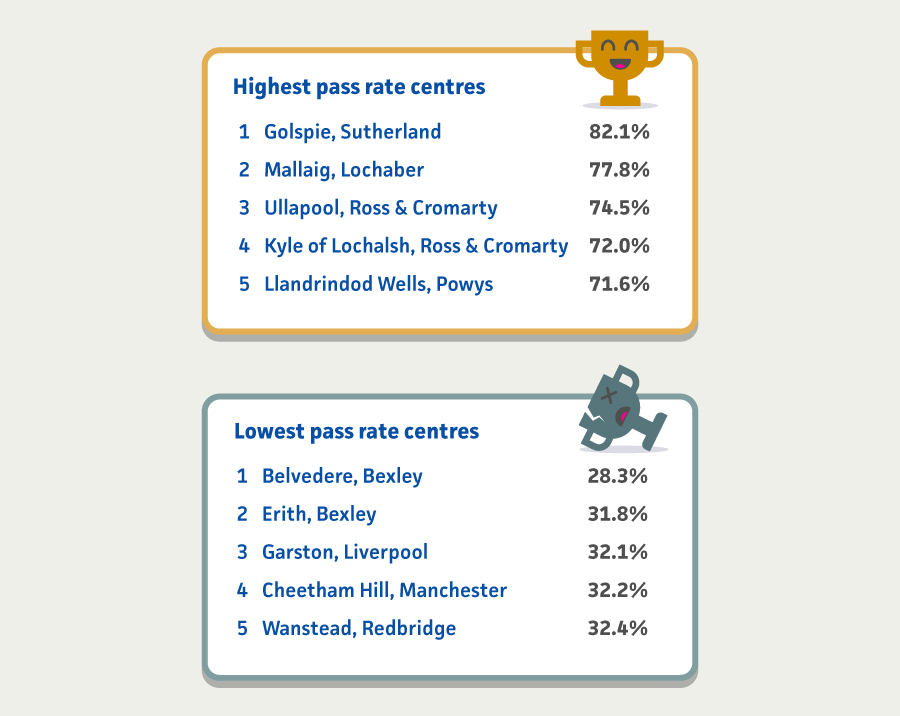
Three of the lowest five pass rates are for driving test centres in London. In addition to Belvedere, Erith, and Wanstead all have pass rates below 33%, meaning at least two in three drivers at these centres fail their driving tests.
There can even be big discrepancies in pass rates between test centres just a few miles apart. For example, there is a 65.9% pass rate at the Ashton Under Lyne test centre, yet five miles down the road at the Cheetham Hill test centre the pass rate plummets to 32.2%.
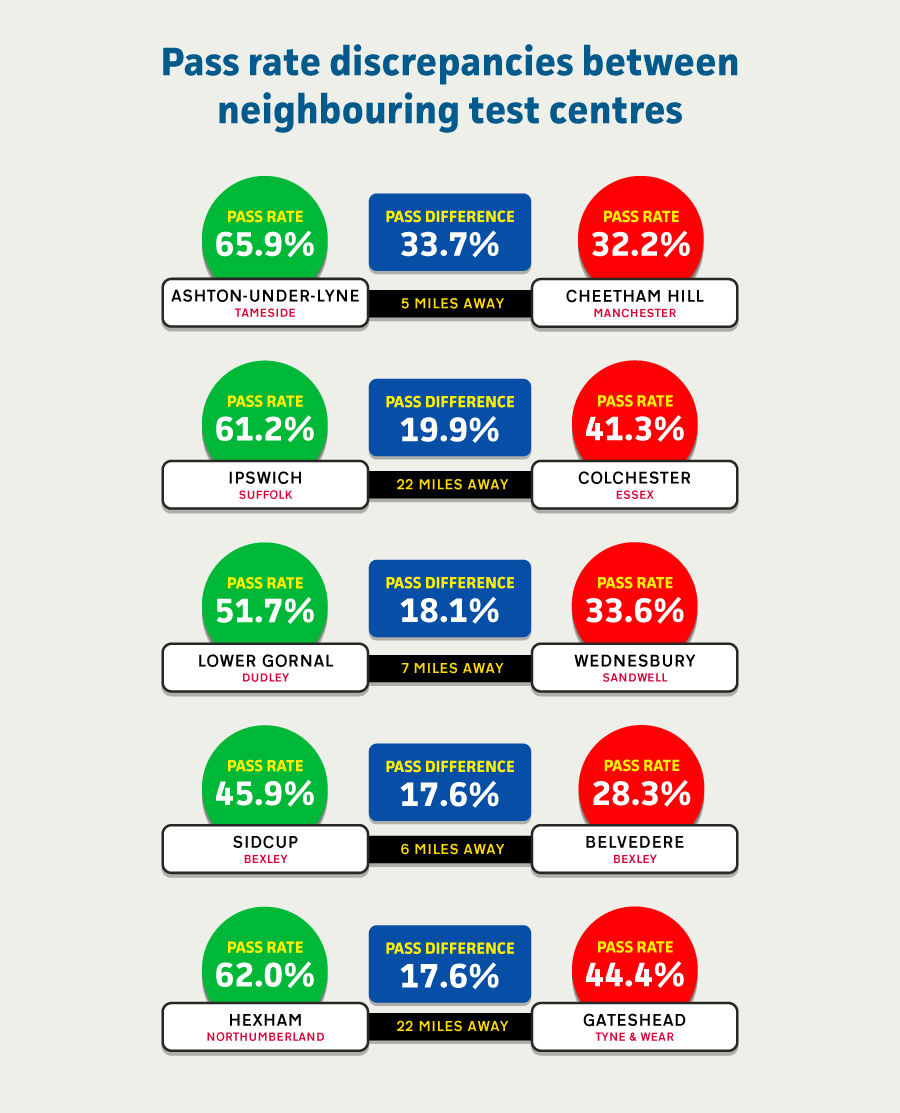
In eastern England, Ipswich test centre has a significantly higher pass rate than both nearby Colchester and Bury St Edmunds.
When it comes to large cities, Edinburgh has the best pass rate at 50.1%. Bristol is in second place with a 48.9% average pass rate and Birmingham comes last behind London on 38.8%.
Putting off driving until later life
Despite the effort that goes into passing a driving test, more than one in ten (12%) drivers do not drive at all within the first year of getting their licence.
There are a host of different reasons for this. While a lack of access to a vehicle is the most common (49%), the sheer expense also prevents some new drivers from getting the chance to build up their experience (38%).
A further one in eight (13%) say they don’t need a car initially, as they are continuing their studies at college or university.
This lack of driving after gaining a licence may be a concern though; more than three quarters (76%) of drivers believe the skills of someone who does not drive for a prolonged period will deteriorate.
What drives the cars that young drivers choose?
Once they have passed their test, many young drivers’ thoughts will turn to what car to buy. But what influences the cars they choose to drive?
Well, status for one. Around a third of drivers aged under 25 admitted to buying a car for prestige, with a further 25% saying they felt the pressure of picking a car for status or prestige although resisted the temptation to buy.
Social media plays a big part here, with almost a quarter of under 25s saying they were influenced by Facebook, while 15% pointed to Instagram as a driving factor.
Forty-two percent said they also followed car related social media influencers or channels whilst 62% of those aged under 25 admitted they had taken pictures of themselves inside their car and posted them on social media.
Perhaps reassuringly, two in five (39%) said their parents influenced their buying decision, while the same amount also said their budget was a key influence.
Borrowing to buy that first motor
Over half of young drivers use car finance to fund their car. The most common monthly budget is between £200 and £299 and almost a quarter (24%) of young drivers are happy to push that budget further being prepared to commit to over £500 a month on car finance to get the car they really wanted.
There is a substantial difference between the sexes when it comes to borrowing in order to finance a car. While the average car loan for female young drivers stands at £8,278, this jumps to £9,975 for men.
Goodbye taxi, hello friends
Learning to drive is a big source of social freedom - no longer are you relying on mum and dad to give you a lift. In fact, for many young drivers it’s the biggest reason for wanting to learn, with more than a third of Admiral drivers having insurance cover just for ‘social’ use.
But that freedom comes with an added cost to consider – filling up at the pump.
Petrol money
Deciding who covers the cost of fuel when a group of young people are journeying together can cause some awkwardness. Admiral research found that among drivers under 25 years old, 62% said they had given somebody a lift and thought they should have been offered money in return. Just 18% said they regularly ask for money, whilst 21% said they would if it was a long journey.
This age group is polite to a fault when it comes to accepting petrol money too. Almost two-thirds (59%) said they felt too awkward to ask for a contribution towards the fuel when giving a lift, while a whopping 91% admitted turning down the offer of petrol money even though they really did want to accept.
Giving it up to get on the road
Young drivers are so keen to get on the road they are willing to make a host of sacrifices.
Research from Admiral found that more than two-thirds of under 25s (69%) said they would give up spending on new clothes in order to keep their car on the road, while socialising with friends and going to gigs and festivals would be given up by 60%.
More than one in ten (13%) said they would even postpone saving for a deposit on a property in order to have the money for their motor.
On the road
Those just starting out on the road will obviously face higher car insurance premiums than drivers with years of experience behind the wheel.
Higher cost and frequency of claims is the predominant reason why car insurance for young drivers is much more expensive. Young drivers under 25 have a claim rate that is 27% higher than for drivers over 25. Personal injury claims also make up 32% more of all claims for under 25s than over 25s and the average claim cost is 35% higher for an under 25 than over 25.
Admiral data shows that one in five accidents involving young drivers has an injury claim and that 30% of all injury claims are for a driver aged under 25.
Industry data shows that the average annual insurance premium for a 17-year-old is £1,889. Men tend to pay more, with the average car insurance policy coming in at £2,294 for a 17 to 20-year-old male and £1,660 for a 17 to 20-year-old female in 2018.
This is significantly more expensive than the premiums for older drivers with a history of safe driving.
Of course, different motors attract different premiums, so picking the right model can make a massive difference to the cost of car insurance for young drivers. But what cars are young drivers most likely to go for?
Be warned that even with these models, the average premium that a 17-year-old is likely to face will be around 67% more expensive than if they were a 24-year-old driver.
There are ways to reduce the cost of very high premiums though. Telematics (or black box) car insurance policies see your vehicle fitted with a small black box, which monitors the way you drive. If young drivers show that they are responsible - for example, they don’t speed, brake harshly and avoid driving late at night - then the car insurance costs could be reduced in the years that follow.
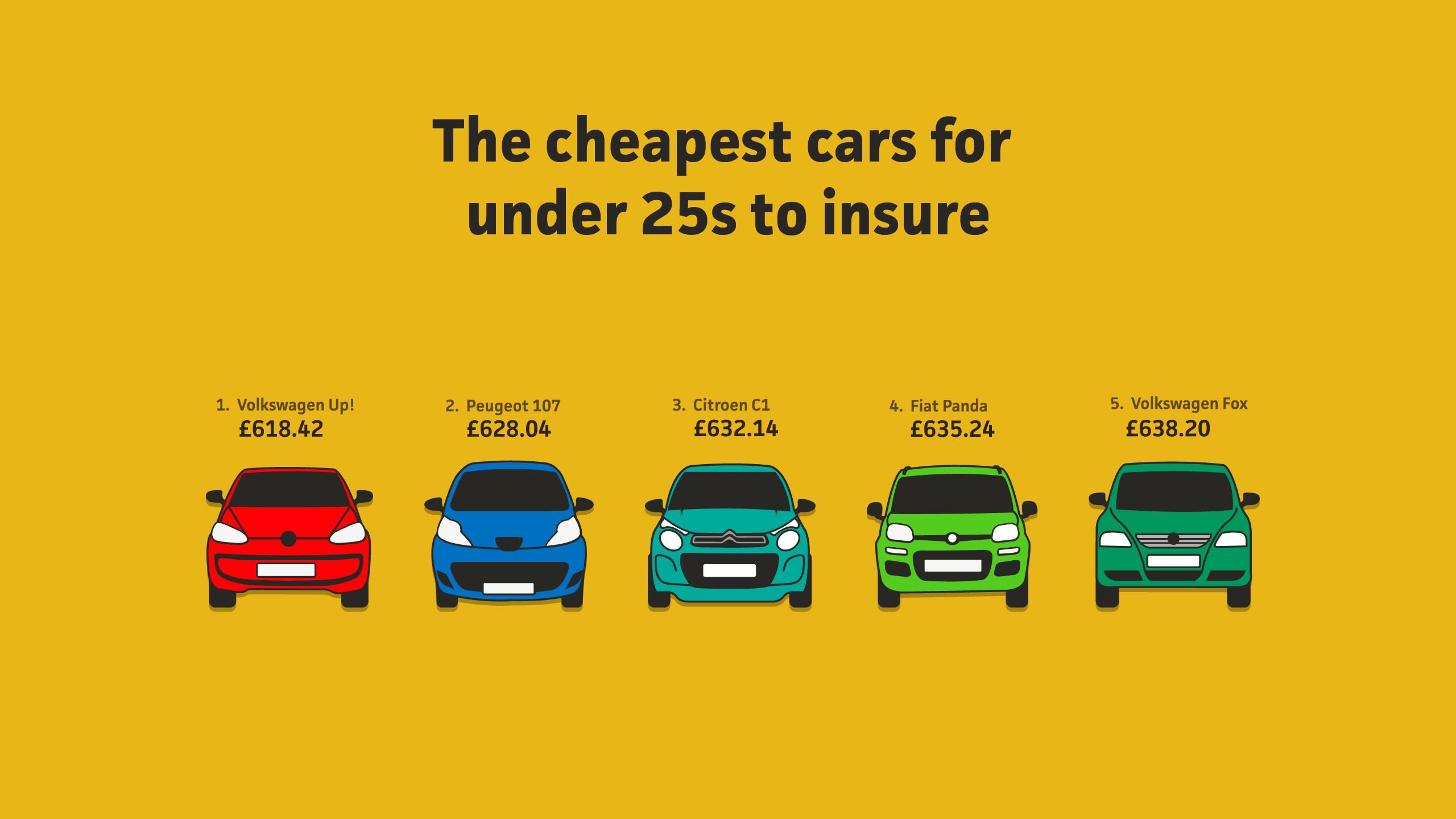
Can young drivers save money by being added to a parent’s policy?
Some young drivers start out by being added to the policy of one of their parents or an older sibling. Admiral data shows that around 4% of drivers aged over 35 have a named driver aged under 25 on their policy, a decision made because it can work out cheaper than arranging a separate standalone policy for the new driver.
But beware of ‘fronting’ where an older driver - perhaps the parent - puts themselves down as the main driver for a vehicle, with the younger driver simply a named driver, though in reality it’s the younger driver that will be using the vehicle most often. Fronting is considered to be fraud.
Putting your foot down
The thrill of independence that comes from getting your licence can lead to some drivers being a little too enthusiastic with the accelerator.
Data from LittleBox, Admiral’s telematics system, shows that in every age between 17 and 25, male drivers are likely to speed more often than female drivers. And it’s the over-21s who speed more frequently than the youngest drivers.
Drivers between age 19 and 21 are the most likely to brake harshly, a sign that they haven’t anticipated the road ahead of them, while male drivers tend to brake more harshly than females.
The safest cities to be a young driver
It’s not just incidents on the road that new drivers need to think about. They also need to pay close attention to the security of their motor when it’s parked up.
Different areas have vastly different crime rates. While drivers in Belfast for example are the least likely to have their car broken into, in London break-ins are far more common.
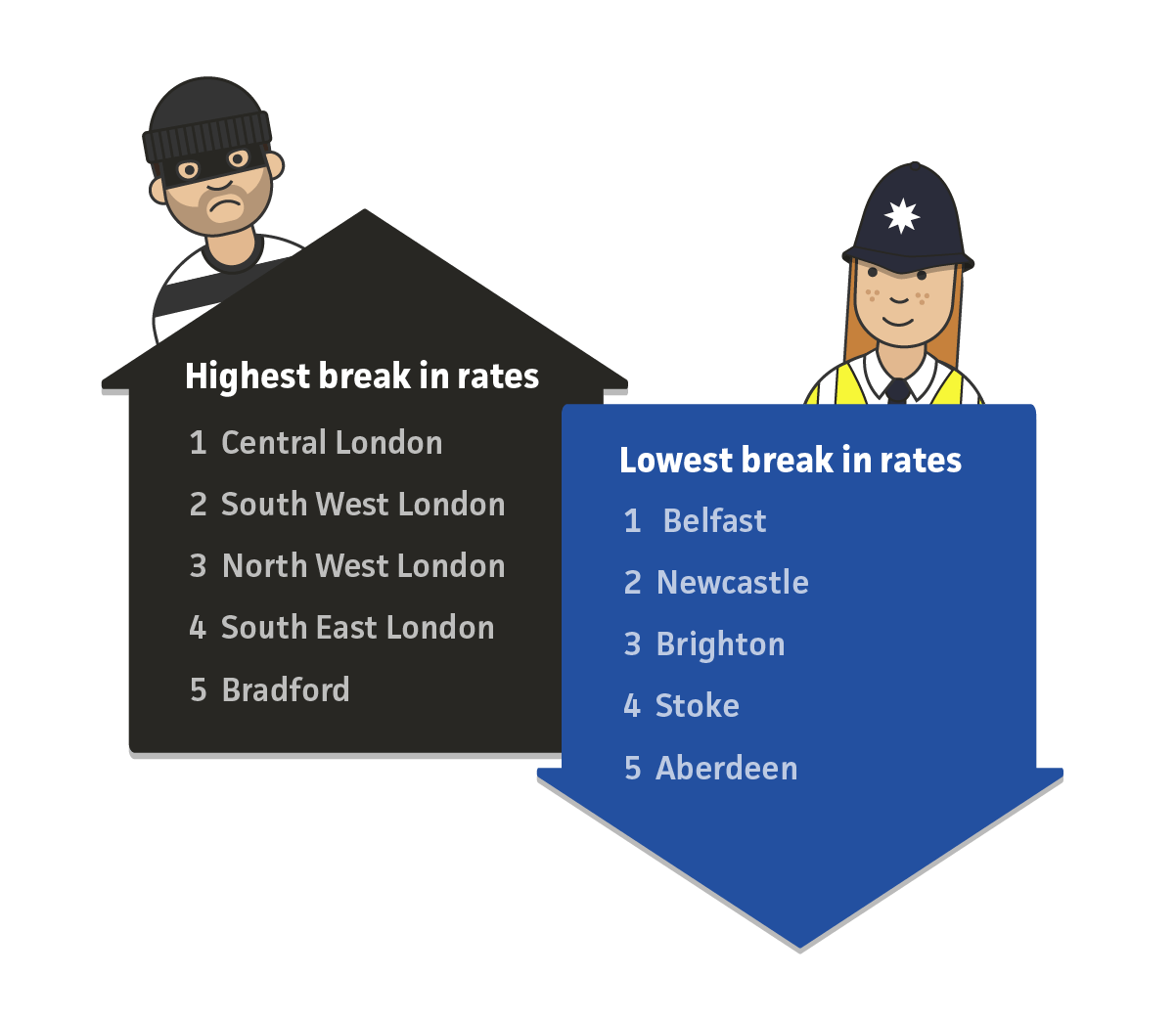
According to Admiral data, Liverpool has the highest frequency of car theft claims, with central London, Birmingham and south west London following behind.
The safest cities to keep your vehicle are Norwich, Newcastle, Belfast and Plymouth.
The Ford Fiesta is not just one of the most popular cars for first-time drivers, it’s also the most commonly stolen. The Volkswagen Golf, another regular choice for new drivers, is also among the most likely to be stolen.
When it goes wrong
It’s not nice to think about, but there are times when things go wrong behind the wheel.
More than a third of drivers have had an accident and have had to make an insurance claim at some point. Most young drivers have their first accident at age 24.
However, young drivers on a provisional licence are unlikely to be caught up in an accident. In 2018, less than 1% of claims for drivers aged under 25 involved those on a provisional licence.
The riskiest times on the roads
Unfortunately young drivers are involved in more accidents than drivers of other ages. According to data from the Department for Transport, and based on the number of miles covered, young drivers were in five times more collisions in England in 2016 than those aged 66-70 years old.
Young drivers are involved in a significant number of write-offs too. Around a sixth (16%) of write-offs from Admiral drivers in 2018 were attributable to drivers between the ages of 17 and 24, with an average car valuation of £3,740.
As a result, it’s crucial that young drivers pay attention to when those risks are greatest.
Almost half (43%) of all accidents on the road take place during rush hour. Admiral analysis found that Friday is the most common day for an accident, with 5-6pm the most common time. Between 8 and 9am on a Tuesday is the prime ‘accident’ hour, with the highest volume of accidents.
Friday
Is the most common day for a car accident and 5-6pm is the most common time
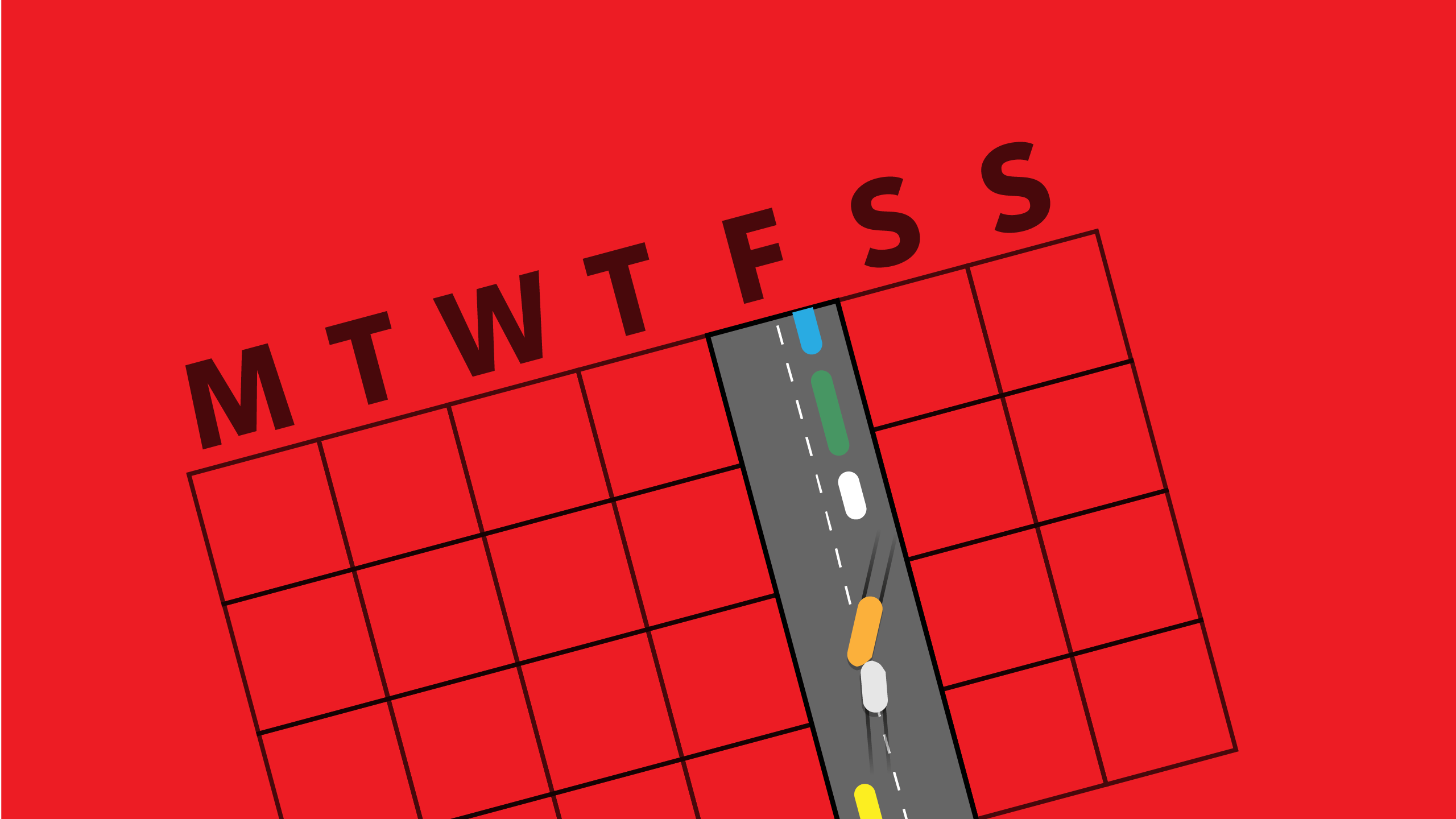
43%
of all claims for accidents made by Admiral policyholders were recorded during weekday ‘rush hour’ traffic.

8-9am
on Tuesday is prime ‘accident’ hour.

Driving offences
When it comes to driving offences, young drivers aged under 25 are responsible for:

Parking conundrums
A little over 4% of all accident claims are related to incidents in car parks.
When it comes to young drivers, it’s women that are more likely to get into a parking pickle, with 8% of claims from young women related to parking, compared to 6% of accident claims from young men.
However, young drivers are actually less likely to get caught up in a problem when parking than their more experienced counterparts. Drivers aged 17-24 are half as likely to make a claim for a parking-related prang as older drivers.
There are big regional differences when it comes to parking claims too. While these claims are most common in Edinburgh, York and Aberdeen, you are least likely to have a parking prang in Bradford, Luton and Birmingham.
The road ahead for young drivers
Learning to drive has long been a rite of passage for young adults in the UK, representing a significant step towards independence. But the world young drivers face today is radically different to that of their parents.
David Stevens, CEO of the Admiral Group, is keen to see more innovation for young drivers to make it easier for them to get behind the wheel. He says:
“Young drivers often need to be able to drive to access the educational and employment opportunities that are vital to their future success, but the cost of motoring for young drivers can be prohibitive.
“We have already seen the rapid growth of telematics. The Association of British Insurers estimates that there are around 1 million policies in the UK helping young drivers get insurance at a price that treats them as individuals, rather than paying the price for other, less responsible young drivers’ behaviour on the road.
“This can only be the start though. There needs to be much more flexibility to meet the needs of young drivers. For example, we need the government to stop looking at car insurance as a nice little earner. The insurance premium tax has been cranked up repeatedly in recent years, jumping from 6% in November 2015 to 12% today, making it the sixth highest rate of insurance premium tax in Europe. This levy hits those who can least afford it the most, notably younger drivers, who typically pay the highest premiums. How can it be fair that an 18-year-old student must pay four or five times as much tax on top of his insurance premium than his 48-year-old father?
“A much fairer system worth considering would be a flat rate of tax, so all motorists pay the same amount regardless of the annual premium.
“It’s also important that the way that young drivers learn and are tested continues to adapt to better reflect modern motoring. At the end of 2017, the driving test underwent various changes, including an independent driving section where drivers are required to follow instructions from a satnav, rather than the driving instructor.
“This is welcome, but we need to continue to look at how we learn to drive and those early months on the road to make sure it remains the best way to prepare a young driver for being on the road alone.
“Graduated licencing, where a young driver gains 6 months’ experience before being allowed to drive at night or have peers in the car with them, is something we need to seriously consider to ensure young drivers are road ready. We know that young drivers will often drive with their friends as passengers and the more passengers you have, the higher the likelihood of a crash. Inexperienced drivers can find passengers a real distraction at a time when they need maximum concentration. I’m keen to see more discussion around supporting young drivers to get on the roads and once they are there, stay safe on the roads.”

